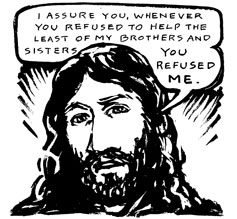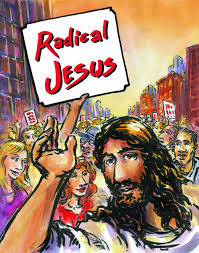Comics /
Spotlight /
Religion and Comics
Radical Jesus: A Graphic History of Faith
By Beth Davies-Stofka
November 6, 2013 - 15:28
Here’s the drivel we hear all the time from my fellow Christians:
God hates gays.
Stop having fun.
You’re going to hell.
Give us your money.
Yuck. (Or, you can substitute another letter for that Y. I can go either way.)
So when you get your copy of
Radical Jesus --
and you should -- flip directly to page 87 and read the final chapter, Nick Thorkelson’s “Radical Resistance.” Thorkelson is a world class storyteller. With lively, wise-guy cartooning, he intertwines the stories of Christian activists across time and space, flowing from one to the other as easily as the Holy Spirit flows from heart to heart.
He gives us the abolitionists who fought nineteenth century slavery, and still fight twenty-first century Jim Crow. He introduces us to the priests who helped protect the poor from Latin American death squads, and the war resisters, who accepted lengthy prison sentences for their symbolic attacks on weapons of mass destruction. He treats us to the story of the Christian Peacemaker Teams, people just like you and me who nonetheless put their bodies in the way of bullets meant to kill others.
These are the Christians that meet in living rooms, not megachurches. Each story has a narrator so real that I thought of picking up the phone and asking to meet one of them, a dignified lady positively oozing love for her neighbors. Erline, a veteran of the Civil Rights Movement, tells the story of Sojourner Truth, a visionary whose staunch faith in the power of the Gospel never seemed to waver. She, and the civil rights activists who came after her, didn’t accept the admonition to wait on freedom. They would not wait. But they would watch, to see the power of the Gospel in action: restoring sight to the blind, setting the captives free, and healing our broken hearts.
Turn next to Chapter 2, “Radical History,” by Gary and Laura Dumm with Paul Buhle. In sharp contrast to Thorkelson’s angular, colorful, jazzy panels, the Dumms use a woodcut-like style and a narrow color palette to tell a variety of stories of Old and New World Christians, from the fourteenth to the eighteenth centuries. The faith of these Christians led them to practice some profoundly radical politics, from pursuing utopian societies, to pushing for abolition, to building peaceful relations with American Indian tribes. Since history is nearly always written by the victors, these searchers of God’s kingdom have largely been forgotten. Prepare to be wowed by their willingness to sacrifice for the sake of others.
 |
Finally, read Chapter 1, Sabrina Jones’ adaptation of the Biblical story of Jesus himself. Jones renders the story in black and white, and her pictures are beautiful: heavy, flowing, swirling images, her Jesus with a very kind demeanor. I have to admit, I don’t know what to make of it. The irregular switching of historical context confused me, and I was troubled to see Jesus cut loose from his Jewish reality. It’s too easy to forget that Jesus was a Jew, and it’s only in the Jewish context that his teachings -- and the teachings about him -- make sense. I struggle to understand Jesus
the Christ, the Messiah and Savior of the world, and that’s because the messianic message only makes sense if you already understand the Jewish context. I missed that here.
However, this chapter does have the ability to inspire you, and if you think you already know Jesus' story and message, then take a look at Jones' Jesus and see what happens. Our world’s great teachers, like Jesus, Moses, the Buddha, and Laotzi to name just a few, spoke such deep truths that they never seem to lose relevance. So see what jumps out at you. For me, it was Jones' lovely rendition of one of the mustard seed parables (p. 17). She shows the beautiful, nourishing tree grown from a tiny mustard seed, filled with nesting birds and astonishing the man who planted it. The “Kingdom of Heaven” is a beautiful tree of food, shelter, and song, and it’s planted in my own mind now.
On page 97, Sojourner Truth sits in a rocking chair and her companion asks her, “Was it all for naught?” Truth responds, “What I say to one I say to all: Watch.” I understand. This book, like the Gospel, is a shield against pessimism and despair. Miss Truth was in her chair, and was going to sit and watch that mustard seed grow.
Biblically grounded and theologically sound, this book is probably misnamed. The subtitle is, more accurately,
A Graphic History of Faith in Action. Read it and be greeted by a quiet Christianity, one populated with hard-working individuals who live for their neighbors, unconcerned for their own success or fame. Read it to understand their history and be touched by their faith. Above all, read this book to liberate Jesus from the haters. Read it, and fight the power!
Rating: A+ /10
Last Updated: January 17, 2025 - 08:20

